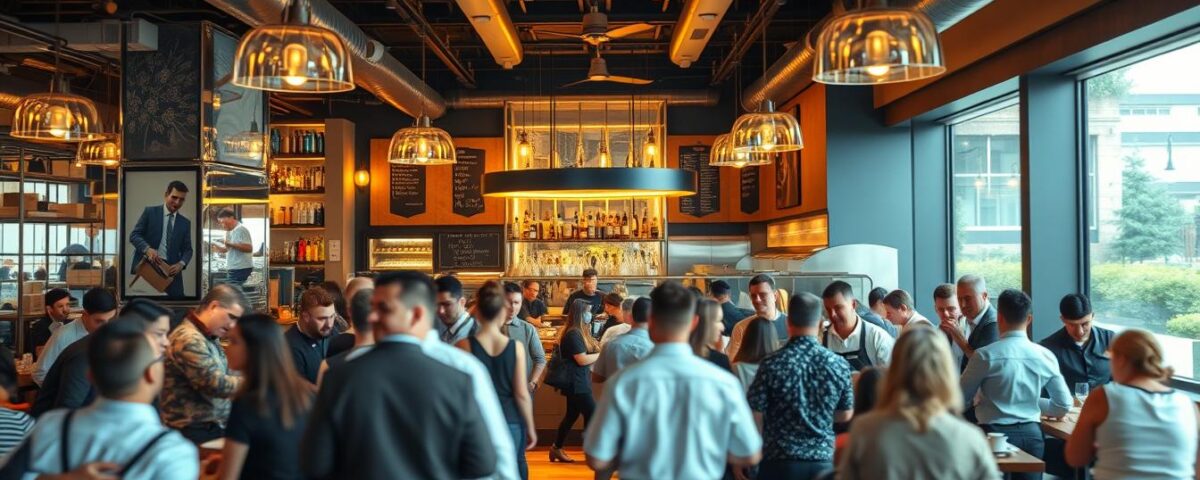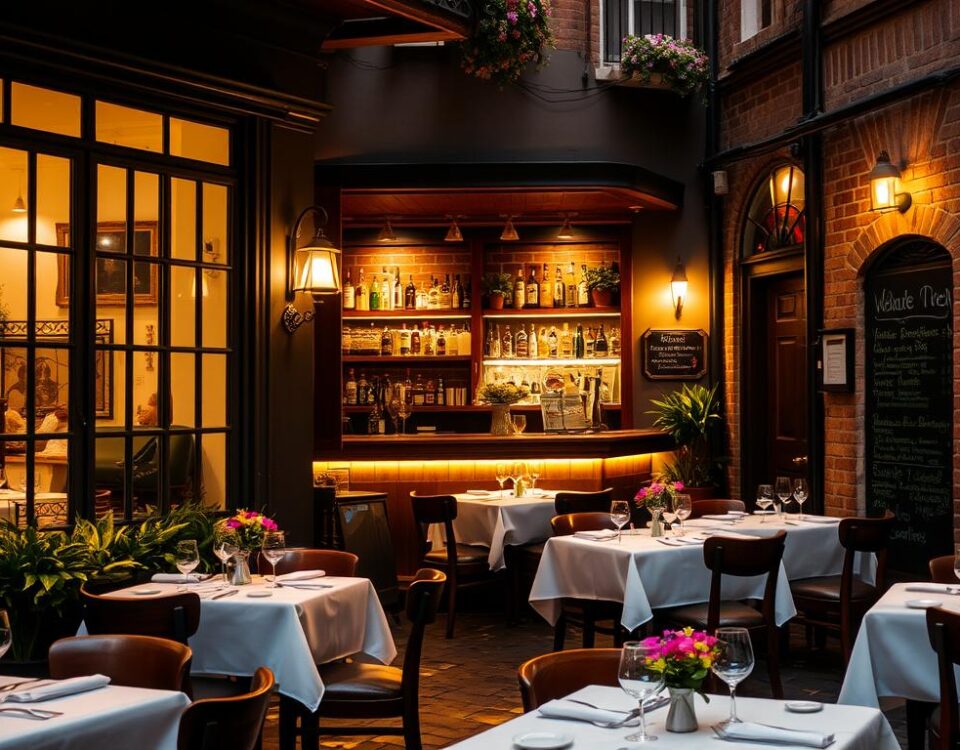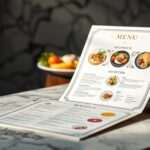
Menu Design Tricks That Get Customers to Choose High-Profit Dishes
July 9, 2025
How to Create FOMO in Restaurant Marketing and Drive Immediate Reservations
July 10, 2025I still remember the chaotic atmosphere at a busy restaurant I worked with, where customers were waiting for over an hour just to be seated. It was a nightmare for both the staff and the patrons. Did you know that poor customer flow management can lead to a loss of up to 20% of potential revenue due to frustrated customers leaving? Efficiently managing the customer flow is crucial for maximizing profit.
By implementing the right flow techniques, restaurants can significantly enhance the dining experience, reduce wait times, and increase customer satisfaction. This not only boosts profitability but also builds a loyal customer base. What if you could transform your restaurant’s operations overnight?
Key Takeaways
- Understand the concept of customer flow and its impact on restaurant profitability.
- Learn how to manage high customer volumes effectively.
- Discover strategies to prevent overcrowding and reduce wait times.
- Explore how different restaurant types can benefit from flow techniques.
- Find out the potential return on investment (ROI) of implementing these techniques.
Understanding Restaurant Flow and Its Impact on Profits
A well-managed restaurant flow is essential for ensuring a seamless dining experience and boosting revenue. Effective customer flow management facilitates coordination between kitchen and wait staff, ensuring fast and efficient service.
Good flow management directly impacts the image of your establishment, leading to increased customer satisfaction. Happy customers are more likely to return and recommend your restaurant to friends and family.
What Makes Restaurant Flow Critical for Success
Restaurant flow encompasses the seamless movement of customers, staff, orders, and food throughout the restaurant ecosystem. It affects every aspect of the dining experience, from entry to exit.
- Defines the seamless movement of elements within the restaurant.
- Impacts every stage of the customer’s dining experience.
- Influences staff utilization and operational efficiency.
How Improved Flow Directly Increases Revenue
Enhancing flow management can lead to significant revenue increases. By optimizing restaurant operations, establishments can achieve better table turnover rates, reduced wait times, and higher customer satisfaction scores.
- Reduces lost revenue from fewer table turns and decreased customer satisfaction.
- Creates a positive feedback loop where efficiency leads to better customer experiences.
- Even small improvements in flow can compound to create significant profit increases over time.
Optimizing Your Restaurant’s Physical Layout
Optimizing your restaurant’s layout is key to improving customer flow and increasing revenue. A well-designed layout facilitates the flow of customers through various stages, from ordering to tasting.
Creating Distinct Functional Zones
Creating distinct functional zones is essential for a smooth customer experience. By defining separate areas for ordering, payment, food preparation, and tasting, you can avoid confusion and mixing of customer flows. This can be achieved by designing the space to guide customers naturally through their dining journey.
Strategic Equipment Placement for Efficiency
Strategic equipment placement is crucial for reducing staff movement and accelerating service. By placing equipment in optimal locations, you can streamline the service process and improve overall efficiency. For example, placing kitchen equipment near the food preparation area can reduce staff movement and save time.
Designing Modular Spaces That Adapt to Customer Volume
Designing modular spaces that can be reconfigured based on volume fluctuations is vital for meeting changing customer needs. By incorporating modular design elements, you can adjust your restaurant’s layout to accommodate peak hours or special events. This flexibility helps to maintain a smooth customer flow and reduce congestion.
| Layout Element | Benefits | Peak Hour Adjustments |
|---|---|---|
| Distinct Functional Zones | Reduces confusion, improves customer flow | Add temporary seating or expand existing areas |
| Strategic Equipment Placement | Reduces staff movement, accelerates service | Adjust equipment layout to accommodate increased staff |
| Modular Spaces | Adapts to changing customer volume | Reconfigure spaces to accommodate peak hour demand |
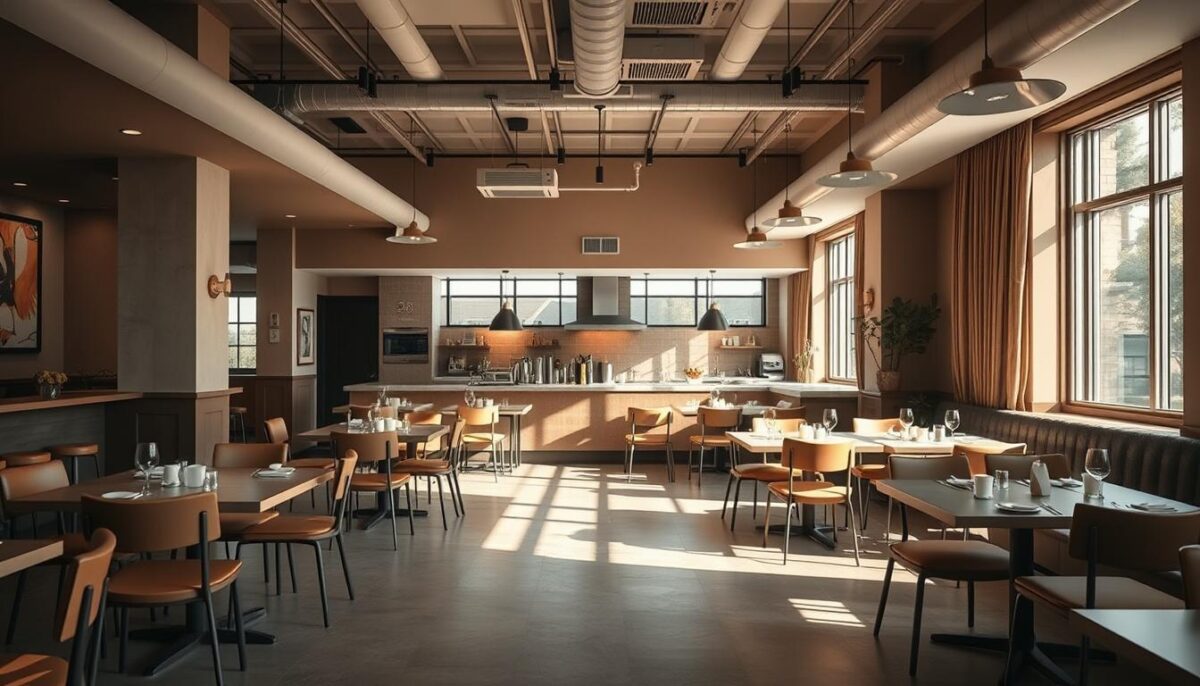
My Proven Restaurant Flow Techniques for Peak Performance
I’ve developed restaurant flow techniques that significantly boost performance. By optimizing the flow, restaurants can increase efficiency, reduce wait times, and enhance customer satisfaction.
Implementing Digital Order Systems to Reduce Bottlenecks
Digital order systems are a game-changer for managing customer flow. By allowing customers to place orders digitally, restaurants can reduce bottlenecks between customers, servers, and kitchen staff. This technology streamlines the ordering process, making it more efficient and reducing wait times.
Streamlining the Customer Journey from Entry to Exit
To optimize the customer journey, it’s essential to map out every step, from entry to exit. By understanding the customer’s path, restaurants can identify areas for improvement and implement changes to enhance the overall experience. This includes using technology to manage wait times and improve service.
Managing Wait Times with Technology
Technology plays a crucial role in managing wait times. Digital waitlist systems and SMS notifications allow customers to join a virtual queue and receive updates on their seating status. This not only minimizes wait times but also enhances the customer experience by giving them the freedom to explore nearby areas.
Building and Training a Flow-Conscious Staff Team
Efficient staff are the key to a smooth customer flow in a busy restaurant environment. They know how to process orders quickly, avoiding errors and ensuring that meals are prepared correctly and on time.
Key Qualities to Look for When Hiring
When hiring staff for a high-volume restaurant, I look for individuals with spatial awareness, multitasking abilities, and the ability to remain calm under pressure. These qualities are essential for maintaining a smooth flow of operations.
Training Staff to Recognize and Respond to Flow Issues
My training program teaches staff to recognize flow disruptions before they become major issues. This proactive approach enables them to take corrective steps to maintain smooth operations, ensuring a better customer experience.
Creating Efficient Staff Rotation Schedules
Managing staff rotas effectively is crucial. By distributing employees to strategic locations according to need, such as checkouts, preparation areas, and service areas, we can optimize our service and minimize waiting times.
| Staff Position | Key Responsibilities | Peak Period Adjustments |
|---|---|---|
| Front-of-House Staff | Managing customer flow, taking orders | Increase staff during peak hours |
| Back-of-House Staff | Food preparation, maintaining kitchen order | Adjust workflow to meet demand |
| Service Staff | Serving customers, handling payments | Ensure adequate staffing at all times |
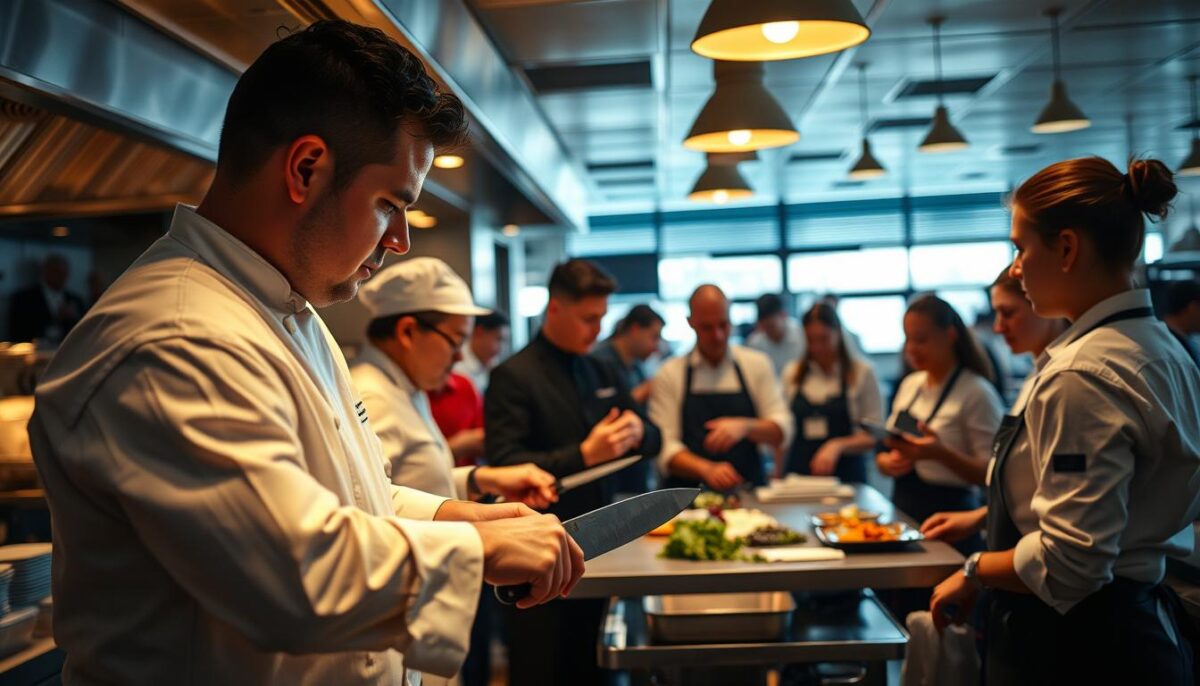
Kitchen Display Systems: The Secret Weapon for Order Management
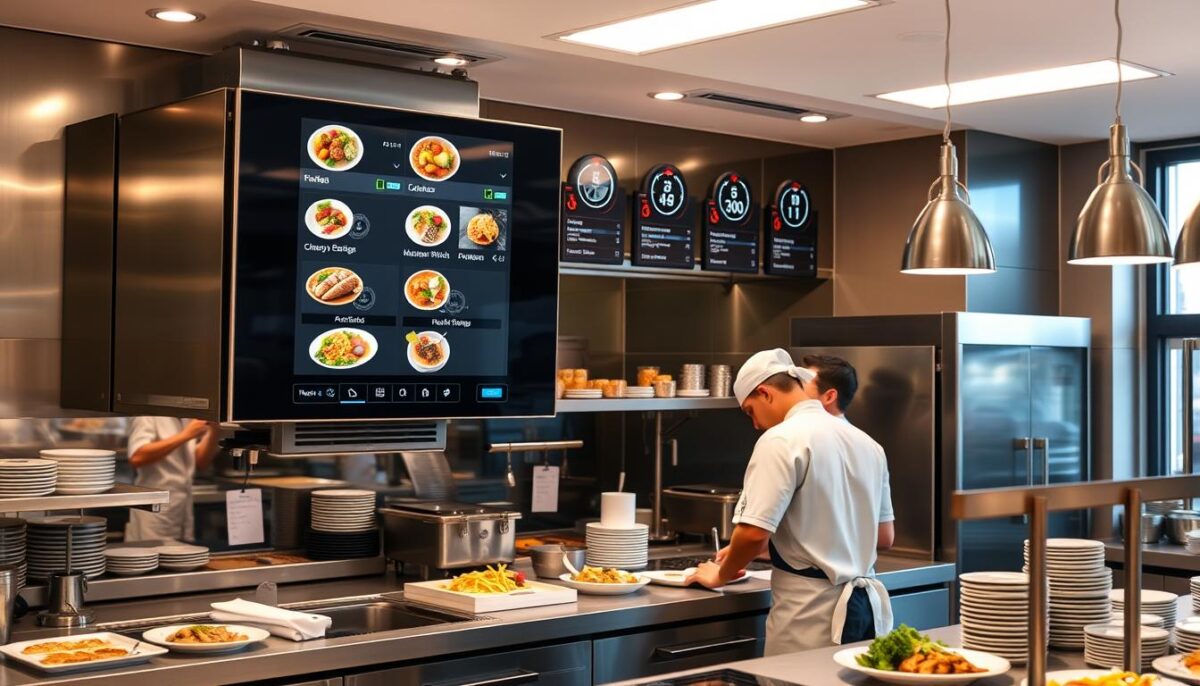
For restaurants aiming to streamline their kitchen operations, Kitchen Display Systems (KDS) offer a game-changing solution. By automating the display of orders from various channels such as cash registers, kiosks, and online ordering systems, KDS eliminates the need for manual order processing.
Transforming Kitchen Operations
KDS technology revolutionizes kitchen preparation by automatically displaying orders on a production screen. This automation saves time by reducing the back-and-forth between waiters and the kitchen, allowing staff to focus on welcoming customers and preparing dishes.
Priority Management with Color Codes and Timers
Modern KDS solutions, like Innovorder production screens, display orders with color codes, audible and visual alerts, and timers to ensure priority management. This feature enables kitchens to manage accumulating orders efficiently and prioritize them based on preparation time.
By implementing KDS, restaurants can significantly reduce ticket-to-table times. For instance, Damien, a BCHEF franchisee in Vannes, reported serving customers in less than 7 minutes even during peak hours thanks to his KDS.
Table Turnover Strategies That Don’t Rush Customers
Maximizing table turnover without rushing customers is a delicate balance that can make or break a restaurant’s profitability. To achieve this balance, restaurants can implement several strategies that optimize table utilization and enhance the overall customer experience.
Optimizing Seating Based on Party Size
Grouping guests by party size is crucial for optimizing table use. By reserving larger tables for bigger parties and using smaller tables for couples or solo diners, restaurants can ensure efficient space utilization. This strategic seating approach prevents the common mistake of seating small parties at large tables, thereby reducing wait times for other customers.
Streamlining the Payment Process
Implementing a fast and efficient payment system enables guests to settle their bills quickly, accelerating the dining process and freeing up tables faster for incoming patrons. This efficiency is crucial in reducing the overall waiting times and improving customer satisfaction. By streamlining the payment process, restaurants can minimize the typical 8-15 minute payment completion time without making customers feel pressured.
Creating a Balance Between Efficiency and Customer Experience
To create a balance between maximizing table turnover and ensuring customers never feel rushed or undervalued, restaurants must focus on naturally pacing the dining experience. This can be achieved by training staff to recognize and respond to customer needs, encouraging solo diners and couples to sit at the bar, and implementing a pre-bussing system that prepares tables for turnover while the current guests are still completing their meal. By adopting these strategies, restaurants can increase their table turns by 25-40% while improving customer satisfaction scores.
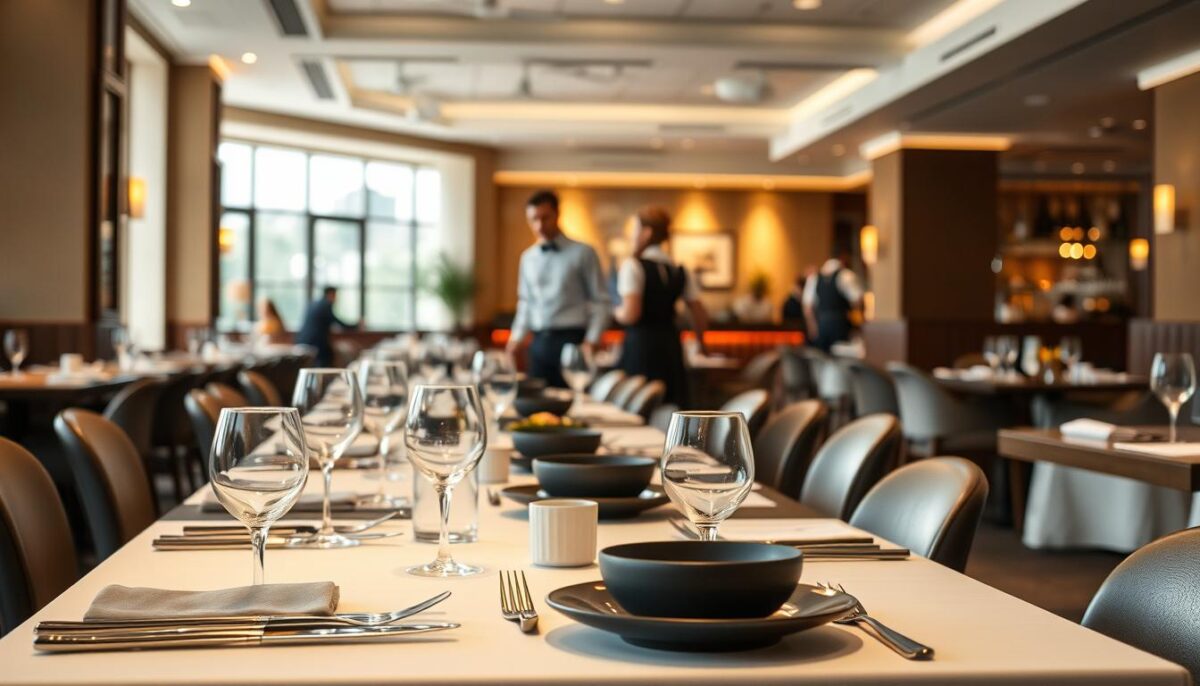
Conclusion: Implementing These Flow Techniques in Your Restaurant
As we wrap up our exploration of restaurant flow techniques, it’s clear that optimizing your restaurant’s operations is key to maximizing profits. By implementing the strategies discussed, such as optimizing your physical layout, streamlining the customer journey, and leveraging technology, you can significantly improve customer experience and increase revenue.
To get started, focus on one area of improvement, such as reducing wait times or enhancing kitchen efficiency. As you implement these changes, you’ll see improvements in your restaurant’s flow and overall performance. Remember, flow management is an ongoing process that requires continuous refinement.
By following these techniques and staying committed to optimizing your restaurant’s flow, you’ll be well on your way to creating a more efficient, profitable business that delights your customers.
FAQ
How can I improve my customer satisfaction while increasing table turnover?
To achieve this, I focus on streamlining the customer journey from entry to exit, ensuring that every step, from seating to payment, is as efficient as possible without rushing my customers.
What are some effective ways to manage customer wait times?
I use technology, such as digital signage or mobile apps, to manage wait times and keep customers informed. This helps to improve their overall experience and reduces perceived wait times.
How can I optimize my restaurant’s physical layout for better operations?
To optimize my layout, I create distinct functional zones and strategically place equipment to enhance efficiency. This includes designing modular spaces that can adapt to varying customer volumes.
What role does staff training play in maintaining a smooth customer flow?
Training my staff to recognize and respond to flow issues is crucial. I look for key qualities in my staff, such as adaptability and attention to detail, and train them to work efficiently, ensuring a seamless customer experience.
How can a Kitchen Display System (KDS) improve my kitchen’s efficiency?
Implementing a KDS transforms my kitchen operations by allowing for real-time order management, reducing bottlenecks, and improving communication between the kitchen and front-of-house staff. I also use color codes and timers for priority management.
What are some strategies for optimizing seating based on party size?
To optimize seating, I analyze my customer data to understand the typical party size and adjust my seating arrangements accordingly. This helps to maximize table turnover without compromising customer comfort.
How can I streamline the payment process to reduce wait times at the end of a meal?
I implement a streamlined payment process by offering multiple payment options, such as mobile payment or contactless payment, and training my staff to be efficient during peak periods.
